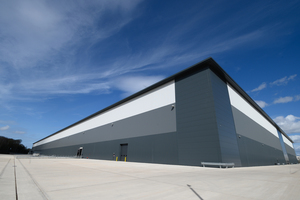

|
Edward Lowton
Editor |


|
| Home> | Efficient Maintenance | >Maintenance products | >Warehouse refurbishment: How EPDM can drive efficiency |
Warehouse refurbishment: How EPDM can drive efficiency
13 September 2024
EPDM single-ply roofing membranes can streamline the refurbishment of logistics buildings, says Carl Bailey

UPGRADING THE roof of a warehouse or distribution centre demands a fast, efficient and durable solution. Eliminating the risk of any downtime to the operation is critical and why EPDM single-ply roofing membranes are now widely specified for refurbishment projects.
Made of synthetic rubber, EPDM membranes are designed for waterproofing flat and low slope roofs and can be installed directly onto most substrates. Manufactured in large sheets up to 15.25 m wide x 61 m long, huge roof areas can be covered quickly by an installer. The size of the sheets also means fewer seams are required to join them together, further increasing on site productivity.
Driving efficiency
An EPDM membrane can be fully adhered, mechanically fixed, or ballasted, largely depending on the size of roof and practicality/compatibility with the supporting elements of the roof construction. For logistics buildings, which comprise large roof areas with few penetrations, usually over a lightweight profiled steel deck, a mechanically attached system is usually the most suitable, providing a fast and cost-effective method.
A ballasted installation will require a support that is able to take the additional imposed load of the ballast, extra equipment to move the stones or pavers but the membrane installation itself can be completed very quickly. The fully adhered method is particularly effective for roofs of an unusual roof shape and more complex penetrations.
Thanks to advances in technology, self-adhered EPDM membranes have been launched recently, providing another option for the logistics industry. An adhesive, which is solvent free and odourless is factory-applied to the membrane’s underside. This enables installers to apply the membrane without the need for additional bonding adhesives or primers on site, eliminating any drying time. On average, this enables a self-adhered membrane to be installed more than 2.5 times faster than a standard EPDM system and requires less labour, reducing costs for building owners.
The membrane can also be applied in temperatures as low as -7 degrees, enabling year-round installation.
A sustainable solution
Once installed, EPDM roofing membranes are highly durable with studies showing they have a life expectancy of more than 50 years. Resistant to UV radiation and extreme temperatures, the membrane is highly flexible allowing it to elongate by more than 300% without any detriment. This means it will return to its original shape and maintain its performance after any expansions or retractions caused by severe weather.
As the membrane is chemically inert it does not contain any volatile ingredients or products that may migrate, so its characteristics remain stable for decades.
As the need for more sustainability increases, EPDM can help to minimise environmental impact too. As well as providing long-term protection for a warehouse or distribution centre, the formulation of single-ply membranes has improved in recent years, almost eliminating the carbon released during operational use.
A system such as RubberGard EPDM can also accommodate new solar panels as will not be affected by the extra heat generated. Furthermore, EPDM is suitable for green roofs and strong enough to accommodate foot traffic associated with future maintenance.
Carl Bailey is regional technical manager for Elevate UK and Ireland
For more information:
Tel: 01565 756186
- 72% of business data breaches came via unsecured wireless devices
- Helping to triple turnover for Flying Fish
- BPMA announces new President
- Digital boost for UK manufacturing
- Bio-Guard range utilises Polygiene Biomaster
- Did we celebrate autonomous quality inspection too soon?
- SHW Live Manchester rescheduled to May 2022
- Universities propose ways of sparking UK growth
- SHW Live signs media partnership with IPE
- Tanged inserts



















